This was published 9 years ago
Mauritius travel guide: The jewel of the Indian Ocean
A dramatic beauty with a languid soul, Mauritius soon converts visitors to its stately pace, writes Brigid Delaney.
By Brigid Delaney
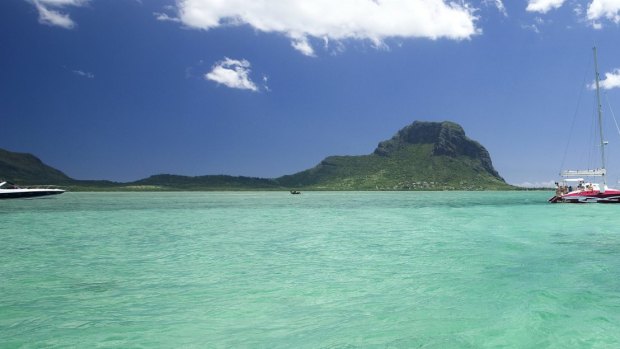
Emerald green: Seas off Mauritius.
We first see Mauritius at dusk, arriving after a six-hour flight from Perth. It's a lovely time to cross the island. After taking a picturesque road that hugs the coast, we go inland. The sky is big, wide and low. In the foreground are sharp, jagged mountain peaks.
The mountains – including the spectacular Le Pouce – get their distinctive edges from the lava that flowed thousands of years ago – setting and transforming the landscape to what it is now – fertile soil, undulating and dramatic.
Along the highway, sugar cane grows neck-high and the warm night air evokes far north Queensland.
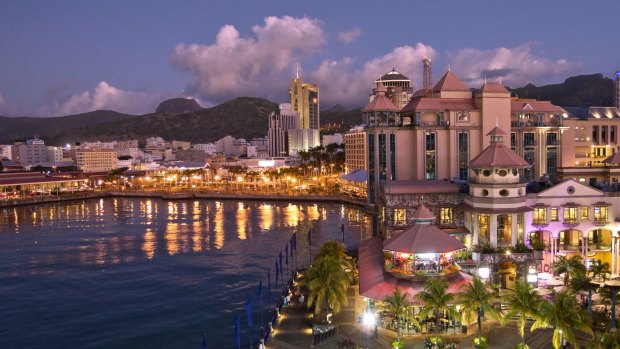
Night view: Port Louis, Mauritius. Credit: Mauritius Tourism
But then we pass little villages – no more than a few shops, shacks, outdoor bars and old factories with signs in French and I realise we are a long way from Queensland.
Despite a strong Mauritian diaspora, particularly in Melbourne, the country remains a mystery to many Australians.
It gives off a strong whiff of glamour – part of an elite group of islands – St Kitts, the Seychelles, St Barts, Bora Bora, Mustique – where the rich play.
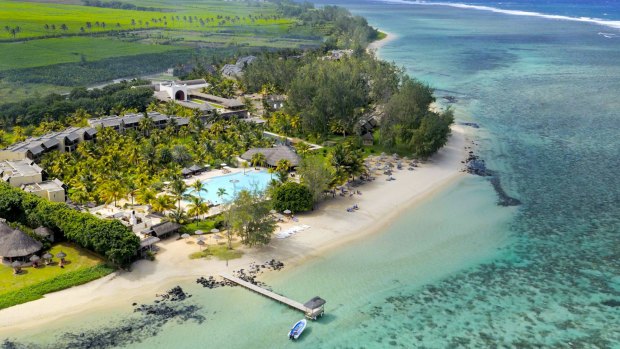
Idyllic setting: Outrigger Mauritius Beach Resort.
But not much is widely known about Mauritius. For example – could you name its president? Or its primary industries or Mauritians who have become famous on the world stage?
When I tell people I am going there, they ask tentatively, as if they should know: "where is it exactly?"
Mauritius is 2000 kilometres off the south-east coast of Africa, near Madagascar and Reunion Island in the Indian Ocean. One gets there by flying to Perth then connecting with Air Mauritius, which flies the six-hour trip to Mauritius twice weekly.
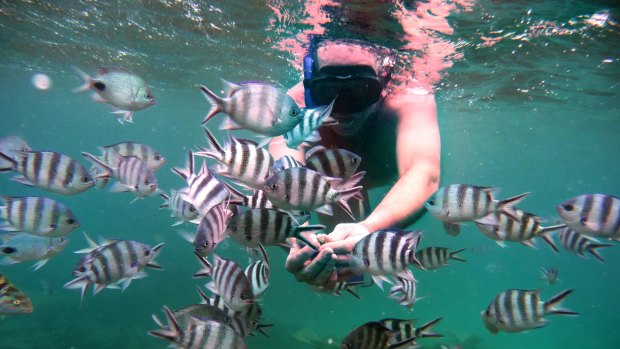
Friendly fish: Snorkelling in Mauritius.
Australians have their choice of islands. There are the Whitsundays then Bali, Thailand and, to the east, Samoa, Noumea, and Tahiti.
So why go to Mauritius?
Apart from its physical beauty (think streets lined with orange blossoms and jacaranda trees, around every corner, a shimmering, mint-green ocean) Mauritius is a fascinating melting pot.
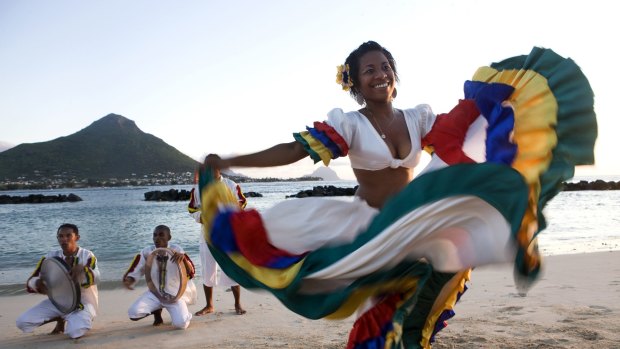
Swirling colours: A woman performs the sega, the national dance of Mauritius.
Its people, cuisines, and languages are a mixture of so many influences – French, African, Senegalese, Indian – that it is unlike anywhere else in the world.
An officially English-speaking former Dutch, French and British colony, it is Africa's farthest flung nation, an 1800-square-kilometre island surrounded by smaller islands. Mauritius is also religiously diverse – with a mix of Hindus, Muslims, Catholics, Anglicans and Buddhists. Locals are justifiably proud of the lack of sectarianism in Mauritius – with mosques, temples and churches built near one another.
As well as being stable and relatively prosperous, Mauritius has a well developed tourism industry.
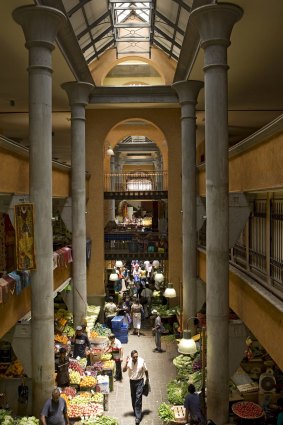
Central Market Port Louis, Mauritius.
Robert De Niro, J K Rowlings and Prince William have all holidayed there – and it was a favourite of Princess Margaret, who visited Mauritius in 1956.
Archival material unearthed recently shows the amusing 1956 "royal rider". In preparation for her visit, Clarence House informed Sir Robert Scott, governor of Mauritius, about the princesses' like and dislikes.
"Princess Margaret prefers meals to be as simple as possible and not to last too long. Three or four courses (including cheese or fruit) for lunch, and five for dinner are quite sufficient."
The princess also liked gin, whiskey and soda and wine. The visit was a great success.
That sense of abundance survives from Princess Margaret's time. In Mauritius I eat prawns the size of my hand, swim in waters filled with the most exotic sea life – including snorkelling over a lethal sea snake – and drink rum (made locally) that would make a pirate forever dock his ship.
It's a tax haven that is resplendent with resorts but the locals, compared with many African nations, have a higher standard of living. Everyone has access to electricity and water, for example. Sugar, fishing and tourism are the main industries. And it is stunningly beautiful. Even though one feels for explorer British Matthew Flinders who was imprisoned on the island from 1803 to 1810 for not having the right papers (ones that corresponded with his ship vessel number) – what a stunning place to be jailed.
It's tempting with so many great resorts in Mauritius to just stay poolside. And, staying at the wonderful Outrigger Mauritius in Bel Hombre, I did just that for several days – but it's easy to make day trips around the island – as nowhere is more than a couple of hours away. I took a guide – Vicky from the tour company Solis – who promised to show me another side to Mauritius that didn't just involve cocktails by the pool.
The Mauritius coast can be carved up roughly into four main areas.
On the windy north coast, sailing, waterskiing and wind surfing are popular. It's also the main entertainment hub on the island, with many bars and restaurants.
The east coast has long, pristine beaches and is beloved by scuba divers.
The south coast is rugged, with plenty of nature reserves. It's popular for nature treks and quad biking.
On the west coast surfing is popular, as is pleasure craft sailing (I took a catamaran out to Tarmarin Bay with the Solis group and enjoyed a snorkel). There are also schools of dolphin – with the option to swim with them. Our boat got close to the dolphins, as did other boats and the dolphins were almost herded further out into the bay. They gave us the slip several times, swimming under the boat and emerging metres away – jumping through the air, seeming happy to be rid of us.
Mauritius is primarily known for its beaches – so you would need no more than a day – or even an afternoon – to explore its commercial and government centre, Port Louis.
There's something about Port Louis that evokes an earlier time with its 1930s French architecture, latticework and wrought-iron balconies. Tropical flowers are everywhere and the air carries their beautiful scent.
Worth visiting is Fort Adelaide, also known as La Citadelle, with its views over the city, and the Champ de Mars, a handsome racetrack – operating since 1812, which provides a social hub for the city of about 150,000 people. The Mauritius Turf Club is the oldest horse racing club in the southern hemisphere and the second oldest in the world
You should also pop into the central market. You can buy all sorts of souvenir tat – mostly of the sarong, tea towel, T-shirt variety but the food market is where the real action is. There are colourful bunches of tropical fruits, and full to bursting bags of grains.
You can watch roti being made by hand, with office workers scoffing it standing up.The roti is fresh off the grill then dipped in spicy sauces.
Food in Mauritius reflects the island's ethnic makeup. While seafood is popular, of course, you should seek out Creole cuisine. Wanting to sample traditional Mauritian food, I'm pointed in the direction of a simple, home-cooking style restaurant that opens out to the road in the south-western village of Chamarel.
Le Palais de Barbizon is run by the fabulously named Rico L'Intelligent, with cook Marie Ange in the kitchen.
Lunch starts with a traditional Mauritian punch – orange juice, rum, beer, Sprite, and orange Tang powder.
The selection – there is no menu, the food just comes out – is based on fresh l products from nearby vegetable patches.
The first course is like a tasting plate with a range of small dishes – banana peel and salted fish curry, rice, jackfruit, aubergine, pumpkin salad, watercress with potatoes and papaya with salted fish.
The main is a large piece of tuna, cooked simply in a fresh tomato sauce.
A range of sambals and rice serves as accompaniment. as Meanwhile, L'Intelligent moves around the small dining room, greeting customers in French and English.
"We give true Mauritian food," he says. . "We come from many countries – Africa, India, Europe. Our food is all of this – as well as simple cooking from the garden and sea."
A full three-course lunch at Le Palais de Barbizon plus punch will set you back less than A$20.
Following lunch, I spent a happy afternoon doing what I had done all week in Mauritius – swimming, snorkelling and unwinding.
There is a sort of dreamy, languid quality to Mauritius that you don't get in many south-east Asian islands. Even the quieter ones have a sort of hectic vibe – with motorbikes and noise, traffic chaos, touts and thronging tourists. Mauritius moves at a different pace – leisurely, stately – you could almost describe it as regal.
TRIP NOTES
MORE INFORMATION
GETTING THERE
Travel to Mauritius from Perth twice a week with Air Mauritius. The international airport is about 43 kilometres or a 45-minute drive southwest from Outrigger Mauritius Beach Resort. See airmauritius.com
STAYING THERE
Doubles at the Outrigger Mauritius Beach Resort start from about $A366 for a deluxe seaview room (conditions apply). See outrigger.com
The writer was a guest of Outrigger Hotels and Resorts
Sign up for the Traveller Deals newsletter
Get exclusive travel deals delivered straight to your inbox. Sign up now.